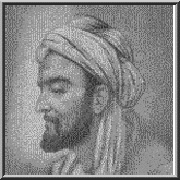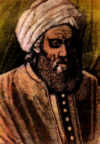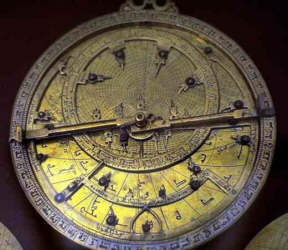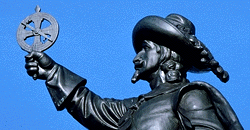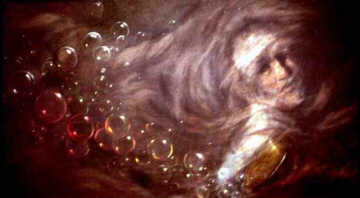Part 1 -- The History of Islamic Spain
Before beginning to analyze the impact of the Muslim world on Western science and technology, it is helpful to understand the history and culture of the Islamic world. Therefore, we will start this section with a tutorial on the history of the Islamic World to 1600, created by the University of Calgary.
You should read the following four web sites before you begin the section on Muslim Contributions to Science and Technology.
The first site you should visit is The History of Islam by Professor John Voll of Georgetown University. Originally a ten page article published in the Encyclopedia of Politics and Religion, ed. Robert Wuthnow; then put online by Congressional Quarterly, Inc.. http://www.cqpress.com/context/articles/epr_islam.html
Next, you should read the history of Spain from a Muslim point of view. After the reconquest of Spain by Christian forces, much of the scientific knowledge that was developed by Muslims came to Western Europe through Spain. Therefore, a knowledge of the Muslim conquest and loss of Spain is crucial to understanding the flow of information. Andalusia, http://www.islamicity.com/mosque/ihame/Sec5.htm
Last, you should read this essay that presents "certain aspects of the Islamic sciences as seen from the Islamic point of view." Science and Civilization in Islam, http://www.fordham.edu/halsall/med/nasr.html
Muslim Contributions to Science and Technology
While most of Europe was living in the intellectually dormant times of the Middle Ages, a different situation existed in Spain. And, this difference can be traced directly to Muslim influences. Spain, even before the Moslem conquests, was the scene of much fighting and territorial disputes. In the early Middle Ages, after the "Fall" of the Roman Empire, Spain was conquered by a confederation of German tribes (around 411 AD). Shortly after, Spain was again conquered by the Visigoths (416 to 418 AD). Kings from Visigoth families ruled Spain for the next two hundred years until the Muslim conquest of Spain that began in 711 AD (Collins, 1995). Over the next 19 years, the Muslims conquered most of Spain and were threatening to conquer France until stopped by Charles Martel (the grandfather of Charlemagne) at Poiters in 732. Click on this link to read three different accounts on the Battle of Tours, http://www.fordham.edu/halsall/source/732tours.html.
As discussed in the University of Calgary tutorial, Spain was ruled for 300 years by the descendents of the Umayyad ruling house. You will remember from the tutorial that the Abbasid Revolution in 750 destroyed Umayyad power in most areas of the Islamic world. However, during the Revolution, the grandson of one of the former caliphs escaped to Spain and set up a kingdom that lasted until the Berbers from North Africa took over in the 11th century.
Scientific knowledge, architecture, mathematics, and philosophy flourished in Spain during the rule of the Umayyad. Much of this intellectual climate can be traced to the precepts of the Qur'an (in English, we sometimes refer to this as the Koran). Throughout the Qur'an, there is a strong emphasis on the value of knowledge. As noted in the tutorial, "because Muslims believe that Allah is all-knowing, they also believe that the human world's quest for knowledge leads to further knowing of Allah. Muslims must thus pursue knowledge not only of God's laws, but of the natural world as well, extending the frontiers of human knowledge. Unlike the revealed knowledge of the Qur'an, Muslims believe that human knowledge is not perfect, and requires constant exploration and advancement through research and experimentation. According to the Qur'an, learning and gaining knowledge is the highest form of religious activity for Muslims, and the one which is most pleasing to God."
|
Abu Ali al-Husayn Ibn Abdullah Ibn Sina (sometimes known in the West as Avicenna) was born in Bukhara in 980. He is arguably the most famous and influential of all the Islamic philosopher-scientists. His famous book, Al-Qanun fi al-Tibb ("The Canon of Medicine") was used throughout Europe for over 600 years. In his writings, he spelled out the procedures for testing the effectiveness of a new drug. Beyond his work in medicine, he also made significant contributions in philosophy, mathematics, chemistry, and astronomy and was the author of over 200 books. |
|
In the Medieval Age, the Muslims led the world in their pursuit of knowledge. Much of this knowledge was discovered by Muslim scientists while other knowledge was derived from other cultures including the Greeks, Persians, Indian, and Chinese. The Muslims synthesized, elaborated, and transmitted this knowledge to Spain; and eventually, to the entire Western world. In Western Europe at this time, most of the knowledge of the Greeks was lost. It was only through the transfer of Greek knowledge (including Aristotle's philosophy, Ptolemy's geography, Hippocrates' medicine) by Islam Spain that this information ever got to Western Europe.
Historians have discovered that there were two major periods of intense scholarly work in the Muslim world during the Medieval Age. The first period was in the 9th and 10th centuries in Baghdad and the second period was the 12th and 13th century in Europe (primarily Spain). In both of these periods, Muslim translators first translated the Greek knowledge into Arabic and then into other languages. Of course, as was discussed previously, Greek knowledge was enhanced and expanded by Muslim scholars. Remember the primary language of Europe at this time was Latin--all the Romance languages (French, Italian, etc) were just beginning to be used and were generally considered to be vulgar (According to the Encyclopedia Britannica (2000), Vulgar Latin "was primarily the speech of the middle classes in Rome and the Roman provinces." After the Roman Empire fell, regional differences in vulgar Latin increased and eventually became the Romance languages.)
"Take Aristotle, for instance. Only a fraction of his work was known in Europe during the post-classical era, when barbarian invasions caused the loss of so much earlier culture. But most of his books were translated into Arabic, and were studied and commented on over and over again in Baghdad and other centers. European philosophers rediscovered them via these commentaries. Ibn Sina (Avicenna) and Ibn Rushd (Averroes) were famous names in medieval philosophy and their predecessor al-Farabi (Alfarabius) is said to have lectured on Aristotle's Physics 40 times and his Rhetoric 80 times" (Zahoor, 1997b).
Why was this knowledge lost to Western Europe? An answer can be found by looking at the time and events that occurred before the start of the European Medieval Age. During the ending centuries of the Roman Empire, Christianity became more powerful and influential, especially after become lawful under the Roman Emperor Constantine (Emperor AD 324 - 337). A consequence of the ascendancy of Christianity was that less authority was given to the pagan, "classical teachings" of the Greeks. The main preserve of Greek writing was in Egypt. However, the Library of Alexandria, one of the largest libraries in Egypt (and the Western world) was destroyed by fire in 389 AD. In this one event, many writings were lost. Also lost and burned was the Museum of Alexandria, a real university, in 415 when riots incited by Christians caused its destruction.
|
Artist Name: Islamic Anonymous |
|
Despite these, the scholarly tradition of the Greeks was preserved in Alexandria and at the university at Jundishahpur (Persia), where excommunicated Nestorian Christian scholars went in 431 and some Greek scholars found refuge after Plato's Academy was closed in 529. According to Abdel-reheem Ead (2000), the transfer of Greek knowledge to the Muslims "was made partly through direct contact in Egypt, partly through the medium of Syrian Christian translators, and partly by way of Persia." It is clear that, when Egypt was taken over in 641 AD by the Muslims, much Greek classical knowledge passed in this way into the Islamic culture. In 636, Persia became part of the Islamic world and Arab rulers continued to support the university at Jundishahpur. Through their translations of Greek texts, Islamic physicians were able to read the works of Hippocrates, Galen and other Greek physicians. In contrast, after the fall of the Roman Empire, all that remained of Greek science were Pliny's Encyclopedia and Boethius's treatises on logic and mathematics (Tschanz, 1997).
The Islamic love of knowledge can be seen in their cities. Every major Islamic city in medieval times had an extensive library; in Cordoba and Baghdad the libraries claim to have had over 400,000 books. We can compare this to the largest libraries in Western Europe that had only hundreds of books. Even into the 14th century, the library at the University of Paris only had about 2,000 books (McClellan & Dorn, 1999).
Muslims referred to Spain as Al-Andalus. This word has several meanings. "One of them is to become green after a long summer or drought, and the history of the Iberian Peninsula over the ages attests to this phase when Muslims ruled Spain" (Zahoor, 1997b). The influence of the Muslim world on Western science can be seen in the vocabulary of science as many of the words used by Muslim scientists have been retained and have entered the English language. Arabic words in chemistry include alcohol, alkali, niter (from which word we get nitrate), alkahest (the universal solvent, sought by the alchemists), and alembic (a distilling flask). Astronomical Arabic terms include almanac, zenith, and nadir (Plambeck, 1995).
Beginning in the Middle Ages, men seeking knowledge would travel to Spain to obtain Muslim science. This may be surprising since we tend to think of the Muslim world as being separated from Europe. But, there were many linkage between these two societies, one being trade and the other, more significantly education. Adelard of Bath, an Englishman in the 12th century, was the first major popularizer of Muslim science in the West. He spent a long time in Muslim Spain learning both about Greek mathematics and science as well as Muslim contributions to science. In particular he introduced Euclid and aspects of astronomy to Western Europe.
"As well as more technical treatises, he wrote Natural Questions - the selections here are from its preface and part of the body - which expresses his fundamental belief that God should not be invoked to explain what human knowledge can." Adelard of Bath: The Impact of Muslim Science. Preface to His Very Difficult Natural Questions, [Dodi Ve-Nechdi] c. 1137 from Medieval Sourcebook, http://www.fordham.edu/halsall/source/adelardbath1.html
The key event for Medieval Europe came in 1085 when the great Muslim city of Toledo fell to Christian military forces. Toledo housed one of the largest libraries in the world at this time. And, this library was filled with thousands of books including Muslim translations of classic Greek philosophers. After the fall of Toledo, this city became the focus of a massive translation effort where teams of translators translated the Arabic texts into Latin. Often, this was not a one-step process. Jewish intellectuals frequently served as the translators--translating Arabic into Hebrew for themselves and then into Spanish for the Christians. But, because most of Europe spoke Latin, the works were then translated into Latin (often by priests or monks). One translator, Gerard of Cremona (1114-87) worked for forty years in Spain translating, with a team, over 70 books from Arabic originals including the works of Archimedes, Galen, Hippocrates, and Aristotle (McClellan & Dorn, 1999). In addition to Toledo, Arab work was found and translated in southern Italy and Sicily (reconquered by Norman knights in the 11th century). By 1200, Europe had recovered most of ancient science as well as appropriating several centuries of scientific, medical, and philosophical work done by Muslim scholars.
In the remainder of this section, we will look at specific scientific innovations and technologies that were transferred to Western Europe through Islamic Spain. The story of these technologies will show the wide range of scientific and technological innovation that occurred in the Middle Ages in Al-Andalus. I have divided this into three sections: mathematics, astronomy, and chemistry and medicine.
Mathematics
In Europe during the Medieval Age, scholars used the Roman number system. For those of you who remember the Roman number system from school, you will remember that it is not particularly use to add and subtract. And, the Roman numeral system was great hindrance to the economic development of Europe. The Muslim world, instead, used a different number system--the Arabic number system that we use today.
Although having the name "Arabic number system," Arabic numerals were actually invented in India by the Hindus around 600 AD. You can visit the website, An overview of Indian mathematics, to get more details about the role on Indians in the history of mathematics, http://www-history.mcs.st-and.ac.uk/~history/HistTopics/Indian_mathematics.html.
A problem with the Hindu system is that it was written backwards. So, the number thirty-two would be written as 23. According to the web site IslamCity (http://www.islamicity.com/Mosque/ihame/Ref6.htm), "One of the great centers of learning was Baghdad, where Arab, Greek, Persian, Jewish, and other scholars pooled their cultural heritages and where in 771 an Indian scholar appeared, bringing with him a treatise on astronomy using the Indian numerical system." The Muslims adopted and changed the Hindu system which subsequently became known as the Arabic number system.
As with most other Muslim developments, the knowledge of Arabic numbers spread to Europe through Spain where it was evident that the Arabic number system was superior to the Roman number system, particular in commerce, arithmetic, and algebra. The Codex Vigilanus, written in Spain in 976, is the oldest European manuscript containing Arabic numbers. And, in the 14th century, Arabic numerals became widely used by merchants in Italy. After merchants began using the new number system, their use then spread to the rest of Europe.
|
|
Al-Khwarizmi is recognized as the founder of modern Algebra. The actual name of algebra comes from the title of his most famous book, Kitab Al-Jabr wa al-Muqabilah ("The Book of Integration and Equation"). This book on algebra, in its translated form, was the principal mathematics textbook in European universities until the 16th century.
|
But the contributions of the Muslim world did not end with the Arabic number system. Because the Arabic number system, our decimal system, made mathematical calculations easier, it then became easier to use this number system to describe relationships. This process of using the decimal system to generalize arithmetical processes and relationships evolved into what we call algebra today. This type of mathematical reasoning was a departure from mathematical Greek thought (which is geometric). In mathematics, some of the Arabic terms are algorithm, algebra, and arithmetic.
"The noted Arab mathematician AL-KHAWARIZMI (Muhammad b. Musa AL-KHAWARIZMI ca. 875) wrote a textbook on the subject which now exists only in a number of Latin versions. In these a point is used for zero. In ca. 952 Abu'l-Hasan-al-Uqlidisi wrote the Book of the parts of Indian Arithmetic which contains an explanation and application of decimal fractions...In 1202 Leonardo of Pisa (also known as Fibonacci) published his Liber Abaci, a book of arithmetic and algebraic information. AL-KHAWARIZMI's book was a major influence on Fibonacci" (Gans, 2000).
To conclude our discussion of the contributions of Muslim scientists to mathematics, you should read the following essays.
Arabic mathematics : forgotten brilliance? by J J O'Connor and E F Robertson, http://www-history.mcs.st-and.ac.uk/~history/HistTopics/Arabic_mathematics.html
Abu Ja'far Muhammad ibn Musa al-Khwarizmi's contributions to the creation of algebra, http://www-history.mcs.st-and.ac.uk/~history/Mathematicians/Al-Khwarizmi.html
Astronomy
In addition to their developments in the field of mathematics, the Muslim world made significant contributions to the field of astronomy. In our section on clocks (under Technology in the Middle Age), we noted that the developments in Chinese clock building were influenced by Muslims. During the period beginning with the Mongol conquest of China by Kublai Khan, the Chinese Mongol rulers employed Muslim astronomers. These Muslim astronomers developed improved astronomical instruments (McClellan & Dorn, 1999). At this time (10-12th century), most clocks were used for astronomical and astrological purposes rather than for telling the time of day. So, it is not surprising that Muslim scientists should have been experts both in clocks as well as astronomy.
According to (The Islamic World to 1600), "Part of the reason for the Muslim interest in astronomy is unique to the Islamic faith, and grew from the Muslim attempt to solve practical problems." The Muslim calendar is based upon a lunar system and the arrival of the new moon marked the beginning and end of each month. This was particular important during the month of Ramadan, when fasting is required during the day. A second practical motivation for studying the stars was to determine the direction of Mecca from any location because Muslims are required to face Mecca when they pray.
"These practical concerns for Muslims led to great advancements in astronomy. Observatories were first established in the Islamic world, in major cities such as Baghdad, Hamadan, Toledo, Maragha, Samarkand, and Istanbul, and new instruments were developed. The Muslim invention of the astrolabe, for example, was one of the most important in astronomy until the invention of the telescope in the 17th century" (The Islamic World to 1600).
|
Artist Name: Umayyad Anonymous |
|
The astrolabe was a critical development for both the Muslim and Western world. (A history of the astrolabe is given at http://www.astrolabes.org/pages/history.htm. And, there are several different types of astrolabes. By far the most popular type is the planispheric astrolabe, on which the celestial sphere is projected onto the plane of the equator. A planispheric astrolabe consists of two flat circular disk. One of the disks has a map of the sky on its face. The second disk shows the horizon, the lines of altitude for a specific latitude and the zenith (The zenith is the "point of the celestial sphere that is directly over the observer and 90 degrees from all points on that person's horizon" (Encarta, 2000)).
As you can see from the photo above, the astrolabe is mounted in a case with degrees marked around the perimeter and arms mounted in the center. To use the astrolabe, you move the moveable arms to a particular location.
"Astrolabes can be used to solve many astronomical problems that would otherwise require rather sophisticated mathematics. All of the everyday uses of the astrolabe are not known, but they were certainly used to tell time during the day or night, to find the time of sunrise and sunset and, thus, the length of the day, to locate celestial objects in the sky, as a handy reference of celestial positions and, as astrology was a deeply embedded element of the cultures that used astrolabes, to determine aspects of horoscopes. Islamic prayer times are astronomically determined, and the astrolabe could be used to determine the required times" (Morrison, 2000).
|
Another kind of astrolabe was a navigational astrolabe. The astrolabe allowed a sailor to determine his latitude--the north-south position. To do this, the sailor would align the horizontal axis of the astrolabe with the horizon. He then pointed it at the sun and read its position on the outer disk. He could then find his latitude by consulting an astronomical table (usually in a book). You can read more about The Mariner's Astrolabe at http://www.astrolabes.org/pages/mariner.htm |
|
Many of you have probably heard of Omar Khayyam through his famous book of poetry, the Rubaiyat. But, in his time and until the 19th century, Omar Khayyam was much more famous as a scientist. His most famous work was in the areas of mathematics and astronomy. When working for the sultan Malik-Shah Jalal al-Din, he created the Jalali solar calendar which still is the most accurate calendar that exists today with only an error of one day in 3330 years.
|
|
Title: Scene from Rubaiyat. |
The following web essay will give you more details on the Muslim contributions to Astronomy.
Uses of the Astrolabe (in the Middle Ages), http://www.astrolabes.org/pages/uses.htm
Chemistry and Medicine
It would be simplistic to look upon the Muslim world merely as the conduit for Greek knowledge transferred to Europe. Yes, the classical works of Aristotle, Hippocrates, and Galen were eventually transferred to Europe through Islamic Spain. However, Muslim contributions to chemistry are more significant than these transfers, particularly in the areas of chemistry and medicine. The medical knowledge available in the Muslim world was so far advanced as compared to the Medieval West. Muslim innovation and work in chemistry and medicine flourished from about 900 - 1200 AD. After the translation efforts of Toledo and other places, books from Arab sources became standard medical texts in Europe.
|
|
Title: De Materia Medica of Dioscorides. Preparation of medicines from flowers & consul |
Why was the Muslim world so far advanced in medicine as compared to Europe? Much of the answer to this question relates to the different worldviews of the two societies. As we noted previously, throughout the Qur'an, there is a strong emphasis on the value of knowledge. And, since the pursuit of knowledge is viewed in a most positive light, experimentation and discovery are encouraged and indeed supported by the government. This worldview is in direct contrast to that existing in the Europe of the Medieval Age.
After the end of the western Roman Empire, the Catholic church stepped into the void created by its end. The Catholic church viewed all knowledge as revealed through the church. Therefore, the pursuit of knowledge for its own sake was viewed with suspicion. Also, the Church placed its emphasis on the soul so medical treatment of the body was not valued. In fact, the hospitals of the Medieval Age, usually run by monks, were places to take seriously ill people to either live or die, based upon God's will. During the Medieval Age, instead of care for the body, lack of care was seen to be evidence of godliness. Mortification, the abuse of the body for spiritual reasons, was widespread during the Medieval Age.
Among the other translations, two significant Arabic medical books were translated into Latin. The first, Introduction to Medicine written by Hunain ibn Ishaq, remained a popular medical text in Europe for 600 years. The second book was written by Abu Ali al-Husayn Ibn Abdullah Ibn Sina (sometimes known in the West as Avicenna). His book, Al-Qanun fi al-Tibb ("The Canon of Medicine") was used in both Europe and the Islamic world from the 11th to the 17th centuries and was reprinted at least 35 times in Europe.
Muslim doctors learned how to use sedatives, they pioneered the use of antiseptics to clean wounds, and they also used sutures made from gut and silk to bind wounds. In all areas of both practical and theoretical medicine, they were ahead of their colleagues in Europe, where people often considered sickness to be the sign of immorality, punishment from God, or "as a condition caused by supernatural forces, which might take the form of diabolical possession" (Tschanz, 1997). One of the greatest breakthroughs in medical knowledge during the Medieval Age came in the 13th century when a Muslim doctor, Muhammad ibn Ahmad Ilyas, discovered how blood circulated in the body.
|
Click on the photo to the left to view a larger picture of an anatomical sketch from the Illustrated Anatomy of Muhammad ibn Ahmad Ilyas, 1396. The US National Library of Medicine in Bethseda, MD has a copy of the anatomy text by Mansur ibn Muhammad ibn Ahmad ibn Yusuf ibn Ilyas. There are many other images from this historical text available at http://www.nlm.nih.gov/hmd/arabic/p18.html
|
The following web sites discuss the contributions of the Muslim (or Islamic) world to Western chemistry and medicine. You should read the essays in this section.
Islamic Chemical Technology, http://scholar.chem.nyu.edu/tekpages/ctechislam.html
Ibn Sina (Avicenna) (973-1037): On Medicine (primary text from the Medieval Sourcebook), http://www.fordham.edu/halsall/source/1020Avicenna-Medicine.html
Islamic Culture and the Medical Arts, an online Brochure to Accompany an Exhibition In Celebration of the 900th Anniversary of the Oldest Arabic Medical Manuscript In the Collections of the National Library of Medicine by Emilie Savage-Smith, University of Oxford, National Library of Medicine, Bethesda, Maryland, 1994, http://www.nlm.nih.gov/exhibition/islamic_medical/islamic_00.html. There are several sections to this online brochure. I recommend that you read several sections so that you get an appreciation of the important role of Islamic scientists to the history of medicine.
Conclusion
This completes our section on the contributions of Muslims to science and technology. In this section, I have focused on four specific areas: mathematics, astronomy, chemistry, and medicine. This does not mean that Muslim scientists and philosophers did not contribute to other areas. In fact, the founder of Algebra, Al-Khwarizmi, directed a team of geographers who produced the first map of the known world in 830. I hope that this short introduction to the Islamic influences on Western culture and science will increase your appreciation of the interactions that existed, and still exist, between different societies.
The next section discusses the contributions of China to the growth of technology in the West.
Chinese Contributions to Technology
References
Abdel-reheem Ead, H. (2000). Alchemy in Islamic Times. http://www.neurolinguistic.com/proxima/articoli/art-49.htm
Collins, R. (1995). Early Medieval Spain (2nd ed.). London: Macmillan Press.
Zenith. (2000). Encarta. go to http://dictionary.msn.com/ and search for Zenith
Gans, P. (2000). Arabic Numerals. http://scholar.chem.nyu.edu/tekpages/arabnums.html
McClellan, J. E., & Dorn, H. (1999). Science and technology in World History. Baltimore, MD: Johns Hopkins University Press.
Morrison, J. E, (2000). Uses of the Astrolabe.http://www.astrolabes.org/USES.HTM
Plambeck, J. A. (1995). Introductory University Chemistry I. University Chemistry: An Introduction. Through the Middle Ages to Alchemy. http://www.chem.ualberta.ca/courses/plambeck/p101/p01013.htm
Vulgar Latin (2000). Encyclopedia Britannica, go to http://www.britannica.com/ and search for Vulgar Latin
Zahoor, A. (1997b). QUOTATIONS ON MOORISH (ISLAMIC) CIVILIZATION, http://www.cyberistan.org/islamic/quote3.html
Other Web Resources
Internet Islamic History Sourcebook. This web site is part of the extensive collection of online history sources available from Fordham University. It is an excellent place to look for primary and secondary sources related to the history of Islam, http://www.fordham.edu/halsall/islam/islamsbook.html
Islamic Medical Manuscripts at the National Library of Medicine, http://www.nlm.nih.gov/hmd/arabic/welcome.html
Medieval Islamic Medicine, http://www.nlm.nih.gov/exhibition/islamic_medical/islamic_02.html
